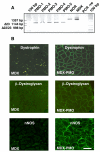Proteomic profiling of antisense-induced exon skipping reveals reversal of pathobiochemical abnormalities in dystrophic mdx diaphragm
- PMID: 19132684
- PMCID: PMC2770591
- DOI: 10.1002/pmic.200800441
Proteomic profiling of antisense-induced exon skipping reveals reversal of pathobiochemical abnormalities in dystrophic mdx diaphragm
Abstract
The disintegration of the dystrophin-glycoprotein complex represents the initial pathobiochemical insult in Duchenne muscular dystrophy. However, secondary changes in signalling, energy metabolism and ion homeostasis are probably the main factors that eventually cause progressive muscle wasting. Thus, for the proper evaluation of novel therapeutic approaches, it is essential to analyse the reversal of both primary and secondary abnormalities in treated muscles. Antisense oligomer-mediated exon skipping promises functional restoration of the primary deficiency in dystrophin. In this study, an established phosphorodiamidate morpholino oligomer coupled to a cell-penetrating peptide was employed for the specific removal of exon 23 in the mutated mouse dystrophin gene transcript. Using DIGE analysis, we could show the reversal of secondary pathobiochemical abnormalities in the dystrophic diaphragm following exon-23 skipping. In analogy to the restoration of dystrophin, beta-dystroglycan and neuronal nitric oxide synthase, the muscular dystrophy-associated differential expression of calsequestrin, adenylate kinase, aldolase, mitochondrial creatine kinase and cvHsp was reversed in treated muscle fibres. Hence, the re-establishment of Dp427 coded by the transcript missing exon 23 has counter-acted dystrophic alterations in Ca2+-handling, nucleotide metabolism, bioenergetic pathways and cellular stress response. This clearly establishes the exon-skipping approach as a realistic treatment strategy for diminishing diverse downstream alterations in dystrophinopathy.
Figures







References
-
- Emery AE. The muscular dystrophies. Lancet. 2002;359:687–695. - PubMed
-
- Ahn AH, Kunkel LM. The structural and functional diversity of dystrophin. Nat. Genet. 1993;3:283–291. - PubMed
-
- Chamberlain JS. Gene therapy of muscular dystrophy. Hum. Mol. Genet. 2002;11:2355–2362. - PubMed
-
- Van Deutekom JC, van Ommen GJ. Advances in Duchenne muscular dystrophy gene therapy. Nat. Rev. Genet. 2003;4:774–783. - PubMed
-
- Bogdanovich S, Krag TOB, Barton ER, Morris LD, et al. Functional improvement of dystrophic muscle by myostatin blockade. Nature. 2002;420:418–421. - PubMed
Publication types
MeSH terms
Substances
Grants and funding
LinkOut - more resources
Full Text Sources
Other Literature Sources
Medical
Miscellaneous

